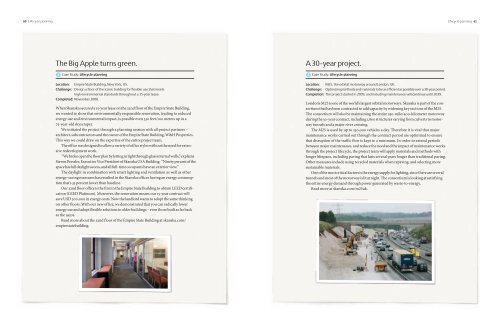Green thinking - Skanska
Green thinking - Skanska
Green thinking - Skanska
- No tags were found...
Create successful ePaper yourself
Turn your PDF publications into a flip-book with our unique Google optimized e-Paper software.
60 Lifecycle planningLifecycle planning 61The Big Apple turns green.A 30-year project.1Case Study: Lifecycle planning2Case Study: Lifecycle planningLocation: Empire State Building, New York, US.Challenge: Design a floor of the iconic building for flexible use that meetshigh environmental standards throughout a 15-year lease.Completed: November 2008.When <strong>Skanska</strong> secured a 15-year lease on the 32nd floor of the Empire State Building,we wanted to show that environmentally responsible renovation, leading to reducedenergy use and environmental impact, is possible even 330 feet/100 meters up in a75-year-old skyscraper.We initiated the project through a planning session with all project partners –architect, subcontractors and the owner of the Empire State Building, W&H Properties.This way we could draw on the expertise of the entire project team.The office was designed to allow a variety of office styles without the need for extensiveredevelopment work.“We broke open the floor plan by letting in light through glass internal walls,” explainsSteven Pressler, Executive Vice President of <strong>Skanska</strong> USA Building. “Ninety percent of thespace has full daylight access, and all full-time occupants have an exterior view.”The daylight in combination with smart lighting and ventilation as well as otherenergy-saving measures has resulted in the <strong>Skanska</strong> offices having an energy consumptionthat’s 35 percent lower than baseline.Our 32nd floor office is the first in the Empire State Building to obtain LEED certification(LEED Platinum). Moreover, the renovation means our 15-year contract willsave USD 300,000 in energy costs. Now the landlord wants to adopt the same <strong>thinking</strong>on other floors. With our new office, we demonstrated that you can radically lowerenergy use and adopt flexible solutions in older buildings – even those built as far backas the 1930s.Read more about the 32nd floor of the Empire State Building at skanska.com/empirestatebuilding.Location: M25, the orbital motorway around London, UK.Challenge: Optimizing methods and materials to be as efficient as possible over a 30-year period.Completion: The project started in 2009, and including maintenance will continue until 2039.London’s M25 is one of the world’s largest orbital motorways. <strong>Skanska</strong> is part of the consortiumthat has been contracted to add capacity by widening key sections of the M25.The consortium will also be maintaining the entire 250-mile/400-kilometer motorwayduring the 30-year contract, including 1,800 structures varying from culverts to motorwaytunnels and a major river crossing.The M25 is used by up to 250,000 vehicles a day. Therefore it is vital that majormaintenance works carried out through the contract period are optimized to ensurethat disruption of the traffic flow is kept to a minimum. In order to extend periodsbetween major maintenance, and reduce the need and the impact of maintenance worksthrough the project lifecycle, the project team will apply materials and methods withlonger lifespans, including paving that lasts several years longer than traditional paving.Other measures include using recycled materials when repaving, and selecting moresustainable materials.One of the most critical factors is the energy supply for lighting, since there are severaltunnels and most of the motorway is lit at night. The consortium is looking at satisfyingthe entire energy demand through power generated by waste-to-energy.Read more at skanska.com/m25uk.

















